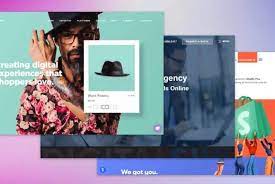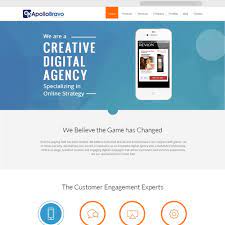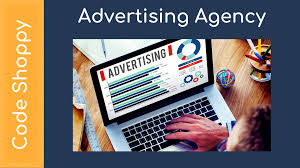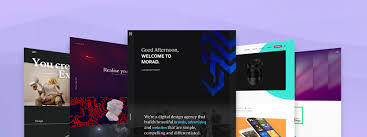The Art of Creative Design Agency Websites
When it comes to showcasing creativity and innovation, design agency websites play a crucial role in making a lasting impression. A well-crafted website not only serves as a digital portfolio but also reflects the agency’s unique style and approach to design.
Visual Impact
One of the key elements of creative design agency websites is their visual impact. From striking colour schemes to bold typography and captivating imagery, these websites use visual elements to engage visitors and convey the agency’s aesthetic sensibilities.
User Experience
While creativity is important, user experience is equally vital in design agency websites. Intuitive navigation, clear call-to-action buttons, and responsive design are essential components that ensure visitors can easily explore the website and discover the agency’s work.
Showcasing Work
Creative design agencies often use their websites as a platform to showcase their best work. Through case studies, portfolios, and client testimonials, these websites demonstrate the agency’s capabilities and highlight successful projects that resonate with potential clients.
Brand Personality
Design agency websites are an opportunity for agencies to express their brand personality. Whether it’s through quirky animations, interactive elements, or playful copywriting, these websites reflect the agency’s culture and values, helping them stand out in a competitive market.
Embracing Technology
Incorporating cutting-edge technology such as parallax scrolling, animation effects, and video backgrounds can elevate the user experience on creative design agency websites. By embracing technological advancements, agencies can create immersive online experiences that leave a lasting impact on visitors.
In conclusion, creative design agency websites are more than just digital platforms – they are works of art that embody the essence of the agency’s creativity and expertise. By focusing on visual impact, user experience, showcasing work, brand personality, and embracing technology, design agencies can create captivating online experiences that resonate with their audience.
Eight Compelling Advantages of Creative Design Agency Websites
- Visually engaging design that captures attention
- Showcases the agency’s creativity and innovation
- Highlights the agency’s portfolio and successful projects
- Reflects the agency’s brand personality and values
- Enhances user experience through intuitive navigation
- Utilises cutting-edge technology for immersive web experiences
- Differentiates the agency from competitors in a crowded market
- Provides a platform for client testimonials and case studies
Challenges Facing Creative Design Agency Websites: Usability, Speed, and Accessibility Concerns
- 1. Overly complex designs can hinder usability and confuse visitors.
- 2. Heavy use of animations and effects may slow down website loading times.
- 3. Lack of clear navigation paths can make it difficult for users to find information.
- 4. Inconsistent branding or messaging across different pages can dilute the agency’s identity.
- 5. Limited accessibility features may exclude users with disabilities from fully engaging with the website.
- 6. Neglecting mobile responsiveness could result in a poor user experience on smartphones and tablets.
Visually engaging design that captures attention
One significant advantage of creative design agency websites is their visually engaging design that effortlessly captures attention. Through the use of vibrant colours, captivating imagery, and innovative layouts, these websites create a visually stunning experience that draws visitors in and keeps them engaged. This attention-grabbing approach not only showcases the agency’s creativity but also leaves a memorable impression on users, making it more likely for them to explore further and engage with the content.
Showcases the agency’s creativity and innovation
Creative design agency websites serve as a powerful platform to showcase the agency’s creativity and innovation. Through unique visual elements, innovative design techniques, and engaging content, these websites demonstrate the agency’s ability to think outside the box and push boundaries in the world of design. By presenting their work in a creative and compelling manner, design agencies can capture the attention of potential clients and leave a lasting impression that highlights their expertise and vision.
Highlights the agency’s portfolio and successful projects
One of the key advantages of creative design agency websites is their ability to effectively showcase the agency’s portfolio and successful projects. By featuring case studies, portfolios, and client testimonials, these websites provide a platform for design agencies to highlight their best work and demonstrate their expertise to potential clients. This not only helps in building credibility but also serves as a powerful tool for attracting new business opportunities and showcasing the agency’s capabilities in a visually compelling and engaging manner.
Reflects the agency’s brand personality and values
Creative design agency websites excel in reflecting the agency’s brand personality and values. Through unique visual elements, engaging content, and interactive features, these websites provide a glimpse into the agency’s culture and ethos. By incorporating distinctive design styles, tone of voice, and messaging that align with the agency’s brand identity, visitors can immediately connect with the essence of the agency. This authentic portrayal helps build trust with potential clients and sets the agency apart in a competitive market, showcasing its commitment to creativity, innovation, and quality in all aspects of its work.
Enhances user experience through intuitive navigation
Creative design agency websites excel in enhancing user experience through intuitive navigation. By prioritising user-friendly design elements such as clear menu structures, easily accessible information, and logical page layouts, these websites ensure that visitors can navigate seamlessly and find what they are looking for with ease. Intuitive navigation not only improves the overall usability of the website but also enhances engagement and encourages users to explore further, leading to a more positive and satisfying browsing experience.
Utilises cutting-edge technology for immersive web experiences
Creative design agency websites excel in utilising cutting-edge technology to create immersive web experiences that captivate visitors. By incorporating features like parallax scrolling, interactive animations, and video backgrounds, these websites go beyond traditional design boundaries to deliver a dynamic and engaging user experience. This pro not only showcases the agency’s commitment to innovation but also sets them apart in the competitive digital landscape, leaving a lasting impression on users and enhancing brand credibility.
Differentiates the agency from competitors in a crowded market
In a crowded market, one significant advantage of creative design agency websites is their ability to differentiate the agency from competitors. By showcasing unique design styles, innovative approaches, and standout projects, these websites create a distinct identity for the agency that sets it apart from the competition. Through visually appealing layouts, interactive elements, and compelling storytelling, creative design agency websites leave a lasting impression on visitors and help establish the agency’s position as a leader in the industry.
Provides a platform for client testimonials and case studies
One significant advantage of creative design agency websites is that they provide a valuable platform for showcasing client testimonials and case studies. By featuring testimonials from satisfied clients and in-depth case studies of successful projects, these websites offer prospective clients real-world examples of the agency’s capabilities and expertise. This transparency and social proof not only build trust but also demonstrate the agency’s track record of delivering high-quality work, helping to attract new clients and establish credibility in the competitive design industry.
1. Overly complex designs can hinder usability and confuse visitors.
Overly complex designs on creative design agency websites can present a significant drawback as they have the potential to hinder usability and confuse visitors. When websites are cluttered with intricate graphics, excessive animations, or convoluted navigation structures, users may struggle to find the information they need or navigate the site efficiently. This can lead to frustration and a negative user experience, ultimately deterring visitors from engaging with the website’s content or exploring the agency’s portfolio effectively. Simplifying design elements and prioritising user-friendly interfaces can help mitigate this issue, ensuring that visitors can easily access and appreciate the agency’s work without being overwhelmed by unnecessary complexity.
2. Heavy use of animations and effects may slow down website loading times.
The heavy use of animations and effects on creative design agency websites can be a significant drawback, as it may lead to slower website loading times. While animations and effects can enhance the visual appeal of a website, they can also increase the amount of data that needs to be loaded, potentially causing delays in loading pages. This could result in a frustrating user experience, especially for visitors with slower internet connections or when accessing the website on mobile devices. Balancing creativity with performance optimization is crucial to ensure that design agency websites maintain a seamless and efficient user experience.
3. Lack of clear navigation paths can make it difficult for users to find information.
One significant drawback of creative design agency websites is the potential lack of clear navigation paths, which can hinder users in finding essential information. When navigation menus are overly complex or unconventional, visitors may struggle to locate key sections such as services, portfolio, or contact details. This can lead to frustration and a poor user experience, ultimately impacting the website’s effectiveness in conveying the agency’s message and attracting potential clients. Clarity and simplicity in navigation design are crucial to ensuring seamless user interaction and facilitating easy access to relevant content on creative design agency websites.
4. Inconsistent branding or messaging across different pages can dilute the agency’s identity.
An inherent drawback of creative design agency websites is the risk of inconsistent branding or messaging across different pages, which can dilute the agency’s identity. When visitors encounter conflicting design styles or varying messaging tones as they navigate through the website, it can create confusion and weaken the overall brand perception. Maintaining a cohesive and unified brand presence across all pages is essential to reinforce the agency’s identity and establish a strong, memorable impression on visitors.
5. Limited accessibility features may exclude users with disabilities from fully engaging with the website.
One significant drawback of creative design agency websites is the limited accessibility features that may exclude users with disabilities from fully engaging with the website. Without proper consideration for accessibility, such as alt text for images, keyboard navigation options, and colour contrast adjustments, individuals with visual or motor impairments may face barriers when trying to access and interact with the content. This exclusion not only goes against the principles of inclusivity but also hinders the potential reach and impact of the agency’s work on a wider audience.
6. Neglecting mobile responsiveness could result in a poor user experience on smartphones and tablets.
Neglecting mobile responsiveness is a significant drawback of creative design agency websites. Failing to optimise the website for smartphones and tablets can lead to a poor user experience, frustrating visitors and potentially driving them away. In today’s mobile-centric world, where a large portion of web traffic comes from mobile devices, ensuring that the website is responsive and functions seamlessly across various screen sizes is crucial for engaging users and maximising online presence. Failure to address this con could result in missed opportunities and hinder the overall effectiveness of the website.




